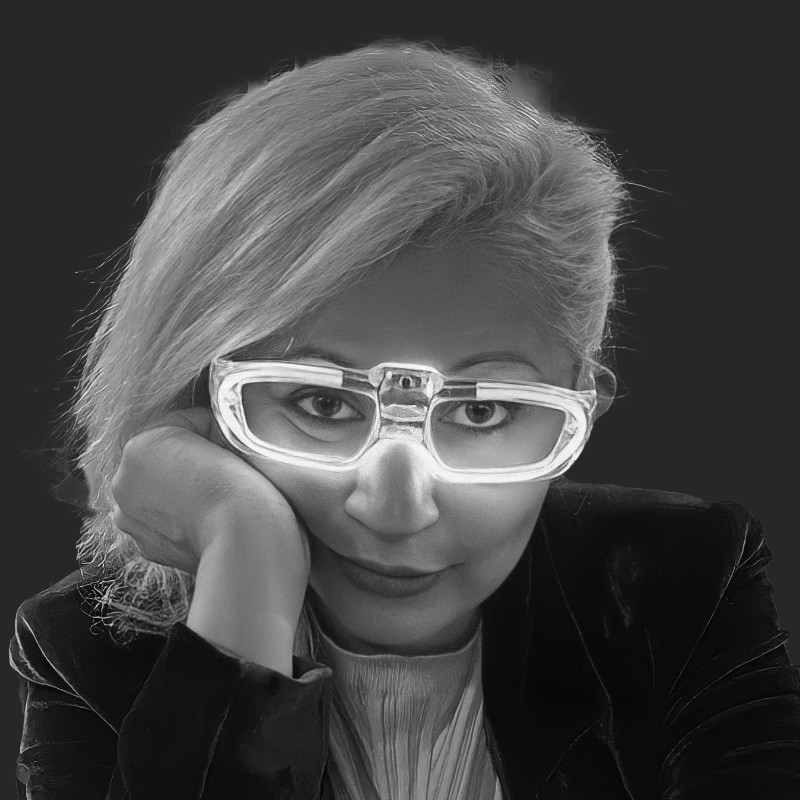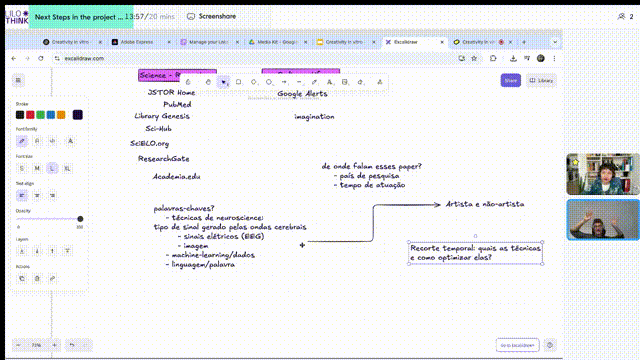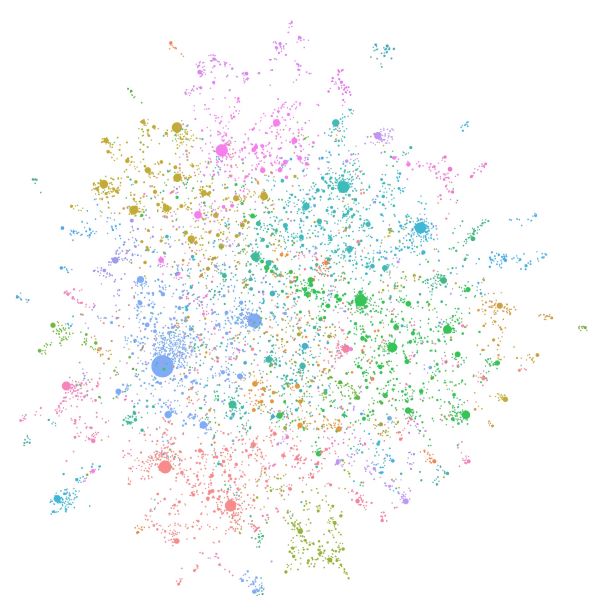Introduction
In our previous exploration, we delved into artworks where brainwaves manifest in light, sound, and fabric. Yet, as I immersed myself in the global landscape of neuroaesthetic art, I noticed the absence of familiar names—artists whose pioneering work I had long admired.
This realization led me to investigate further, uncovering a rich tapestry of South American artists who have been integrating EEG technology into their creative practices. Among them stands Tânia Fraga, a Brazilian architect and artist whose work has seamlessly woven together art, science, and technology for decades.Maida Dance
Tânia’s innovative use of virtual reality and interactive installations has not only expanded the boundaries of computational art but also inspired a generation of artists, myself included. Her ability to harmonize complex systems with poetic expression exemplifies the profound potential of neuroaesthetic exploration.
In this post, I aim to highlight the contributions of Tânia Fraga and other South American artists who have transformed neural signals into immersive artistic experiences. Their work invites us to reconsider the interfaces between mind, machine, and creativity, offering new perspectives on the symbiosis of technology and human expression.
Caracolomobile (2010)
Artists/Collaborators: Tânia Fraga, Mauro Pichiliani, Donizeti Louro (Brazil) Device: Emotiv EPOC (16-channel EEG headset) Medium: Pneumatic kinetic sculpture with sound (robotic installation) Notes: Commissioned by Itaú Cultural for the Art.Ficial 5.0 art and technology biennial (São Paulo, 2010)
Description An interactive snail-shaped robot sculpture that responds to a participant’s brainwaves in real time. An Emotiv EEG headset worn by the viewer captures their “mind fluctuations” – emotional and cognitive states – which a custom Java program interprets and sends to the robot (LNCS 8009 - Experimental Art with Brain Controlled Interface). The robot then expresses these brain-derived states through physical movements and low-pitched sounds, creating a biofeedback loop between the viewer’s mood and the sculpture’s behavior. Caracolomobile used direct brainwave mapping via Emotiv’s affective suite (no additional machine learning), translating the user’s emotional EEG data into immediate audiovisual expressions (LNCS 8009 - Experimental Art with Brain Controlled Interface). This early Brazilian BCI-art piece demonstrated how personal neural activity could drive kinetic art, winning Fraga an award for innovation in 2010.

The Love Project (2014)
Artists: Guto Requena Studio (led by architect Guto Requena, Brazil), in collaboration with D3 design studio Device: Portable EEG headset (plus heart-rate sensor and microphone for voice) Medium: Data-driven 3D-printed sculptures (personalized design objects) Notes: Interactive design/art research project in São Paulo, turning biometric data into “emotional objects” as part of Requena’s Love Project initiative
Description A cross-disciplinary project that converts brainwaves and other biosignals into physical art. Participants wear a lightweight EEG scanner while talking about someone they deeply love; simultaneously, their heartbeats and vocal tone are also recordedhacedores.com. Custom software developed by D3 Studio interprets the EEG, heart, and voice data, mapping each data stream as a layer of a virtual 3D modelhacedores.com. The composite model is then fabricated on a 3D printer as a unique object (e.g. a fruit bowl or lampshade) – every ripple and ridge in the design corresponds to moments of strong emotion detected in the participant’s brain and body signalshacedores.com. This project uses direct biometric mapping (no AI; the design algorithm directly uses the signal data) to create one-of-a-kind art pieces, embedding the participant’s brainwave/emotional “signature” into a tangible sculpture. The Love Project thus blends wearable EEG technology with generative design, preserving human emotional experiences in designed artifactshacedores.comhacedores.com.
MindFluctuations (2014)
Artists: Maida Withers (USA – choreographer) in collaboration with Tânia Fraga (Brazil – visual system) and team in São Paulo, Brazil Device: Emotiv EPOC EEG headset Medium: Live dance performance with generative audio-visual projection Notes: Developed during a residency at the Institute of Mathematics and Art (São Paulo); premiered February 2014 as an immersive stage performance linking dance and BCI
Description: An experimental dance piece where a performer’s brainwaves drive visual art in real time. During the performance, dancer Maida Withers wore an Emotiv neuroheadset, and as she moved, her EEG signals (notably emotional/mental states measured by Emotiv’s software) were fed into Fraga’s Numeric Variations 3D virtual environmentmaidadance.com. The dancer’s brain data directly influenced the colors, forms, and motion of the projected visuals and soundscape on stage. For example, heightened concentration or emotional intensity in the EEG would autonomously alter the speed and behavior of the virtual animations surrounding the dancer. The piece used the headset’s built-in detections (a form of real-time signal mapping) rather than custom machine learning. MindFluctuations thus created a feedback loop between mind and performance: the dancer’s brain activity affected the digital environment, which in turn reacted back to her in an interactive choreographymaidadance.com. This collaboration (with a South American tech-art team and a U.S. artist) showcased the poetic integration of EEG data, live dance, and generative art on stage.
Neuronnection (2020)
Artist: Anaisa Franco (Brazil) Device: NextMind neural interface (EEG-based visual cortex headset) Medium: Interactive light sculpture (brain-shaped, immersive installation) Notes: Commissioned by Institut Ramon Llull/NewArtFoundation; developed at Hangar Barcelona. Debuted at Ars Electronica 2021 (Barcelona Garden exhibition) (ANAISA FRANCO STUDIO : NEURONNECTION Interactive Art)
Description: A participatory installation that “connects thoughts” inside an illuminated sculptural brain. The hanging sculpture – engraved with a neural network pattern – lights up and changes colors in response to the viewer’s focused brain activityemotiv.comanaisafranco.com. Participants wear a NextMind EEG headband and look at designated visual targets (“Neurotags”) within the sculpture; the headset’s AI-based algorithm detects this focused attention from the brain’s EEG signals and triggers dynamic light movements in the sculptureanaisafranco.com. In essence, visitors can mentally “play” with the light: by concentrating, they cause waves of light to propagate through the brain-like form. The EEG data is interpreted via NextMind’s machine-learning model (which translates visual attention into commands), rather than a direct raw signal mapping. Neuronnection creates a closed loop of neurofeedback – as one’s brainwaves light the sculpture, the changing colors in turn influence the viewer’s mental stateemotiv.com. The project uses wearable EEG tech to make intangible thought processes visible, inviting the public to reflect on their own neural activity in an engaging, playful way.
Emotia (2023)
Artist: Camila Rodríguez (Uruguay) Device: Commercial EEG headset (BCI device, brand not specified – used for real-time brain scanning) Medium: Live generative audiovisual performance (brainwave art performance) Notes: Premiered at ExpyFest 2023 (Asunción, Paraguay) as an interactive art+music performance; also presented at Universidad ORT, Uruguay and at Psicología Al Sur festival (Buenos Aires)
Description: A performance piece where the artist’s brainwaves serve as the brushstrokes of a digital canvas. In Emotia, Camila Rodríguez wears an EEG headset on stage and projects her mind’s activity as dynamic visuals (and sound) in real time (Emotia. Arte generativo a través de ondas cerebrales de Camila Rodriguez (UY) – ExpyFest). The raw EEG data is sent through a custom AI system: machine-learning algorithms analyze Rodriguez’s brainwave patterns and translate her emotional and cognitive state into evolving generative art projections (Emotia. Arte generativo a través de ondas cerebrales de Camila Rodriguez (UY) – ExpyFest). For example, heightened arousal or specific emotional states might correspond to changes in color, form, or audio in the immersive visuals. This is not a one-to-one mapping of brain signals, but rather an interpretative translation using AI (ensuring the visuals reflect nuanced emotional content). The result is an “EEG-driven” digital painting that unfolds live, driven directly by the artist’s mind. Emotia explores our inner emotional landscape by making the invisible brain activity visible and artistic, blending neuroscience, creativity, and machine learning in an immersive experience (Emotia. Arte generativo a través de ondas cerebrales de Camila Rodriguez (UY) – ExpyFest). It exemplifies how brain data can be aestheticized — here the performer’s thoughts and feelings, read via EEG, become an artwork that audiences can watch and hear in real time.
Comparative Highlights
Between the previous post (Artworks Where Brainwaves Speak in Light, Sound and Fabric) and this new collection of South American artists working with EEG (Fraga, Requena, Franco, Rodríguez, among others), certain common threads emerge—along with some striking differences.
Shared Threads
Sensory transformation of brain data
Both sets of works translate EEG signals into sensory languages—sound, light, movement, fabric, sculpture, or image.
A desire to visualize the invisible
There’s a shared drive to make internal states—thoughts, emotions, focus, attention—visible and experienceable.
EEG as a poetic tool
None of these works approach EEG as a diagnostic or scientific instrument. EEG is treated as a medium for expression, not analysis.
Interactivity and neuroaesthetic feedback
Many projects are built as feedback loops: the mental state shapes the artwork, and the artwork responds back to the mind.
What the South Brings
Emotional and narrative grounding
Works like The Love Project (Requena) or Emotia (Rodríguez) treat EEG not as raw data but as emotional residue, molding objects or images from memories and inner states.
Tension between control and surrender
Rather than striving for full control, many South American works embrace signal instability, noise, and nonlinear behavior—seen in MindFluctuations and Neuronnection. There’s a kind of surrender to the system.
A poetics of improvisation and encounter
Less focus on technical precision or algorithmic fidelity, more on gesture, presence, and the spark of open-ended experience. This sets them apart from some more formal or institutionally anchored international EEG works.
Quiet, unmapped pioneering
Many of these artists were experimenting with EEG long before neuroart became a trend. Tania Fraga, for example, was already merging virtual reality and algorithmic art in the 1990s, and working with EEG as early as 2010—well outside the dominant tech-art circuits.
 Lina Lopes
Lina Lopes  Cerebral Sync - Week 3/13
Cerebral Sync - Week 3/13